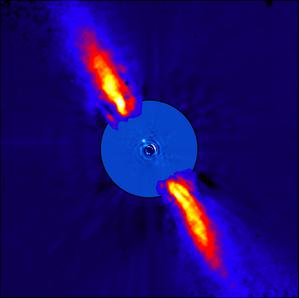Glossary term: অভিযোজনশীল আলোকবিজ্ঞান (Adaptive Optics)
Description: রাতের আকাশে তাকালে আপনি হয়তো দেখছেন যে তারাগুলি ঝলমল করছে। বায়ুমণ্ডলের বাতাস সব সময় গতিশীল, আর কোন নক্ষত্র থেকে আলো যখন একটি অশান্ত এলাকা দিয়ে অতিক্রম করে, তখন এটি বিভিন্ন মাত্রায় বিচ্যুত হয়। এ কারণেই আমরা আকাশে যা দেখতে পাই, তা কিন্তু প্রতিটি তারার জন্য একটি স্থির আলোর বিন্দু নয়, বরং নাচতে থাকা, ক্রমাগত পরিবর্তিত, বিকৃত বিন্দুর অপসরণ। জ্যোতির্বিজ্ঞানীদের জন্য ঝিলমিলানো মানে হল তাঁরা মহাজাগতিক বস্তুর ছবি ততটা বিস্তারিতভাবে নিতে পারেন না যতটা বড় স্থলভিত্তিক টেলিস্কোপগুলি দ্বারা নেওয়া যায়। অভিযোজিত আলোকবিজ্ঞান হলো সেই প্রভাব কমানোর একটি উপায়। বাস্তব তারা বা লেজার-প্রক্ষিপ্ত "কৃত্রিম তারা" ব্যবহার করে একটি অভিযোজনশীল আলোকবিজ্ঞান ("AO") সিস্টেম বাস্তব সময়ে বায়ুমণ্ডলীয় বিকৃতি পর্যবেক্ষণ করে। দুরবিনে প্রবেশ করা আলো একটি বিকৃতিসহনশীল আয়নায় পরিচালিত হয়। কম্পিউটার নিয়ন্ত্রিত এই আয়না বায়ুমণ্ডলীয় বিকৃতি প্রতিহত করার জন্য ঠিকঠাক উপায়ে ক্রমাগত বিকৃত হয়।
Related Terms:
See this term in other languages
Term and definition status: The original definition of this term in English have been approved by a research astronomer and a teacher The translation of this term and its definition is still awaiting approval
The OAE Multilingual Glossary is a project of the IAU Office of Astronomy for Education (OAE) in collaboration with the IAU Office of Astronomy Outreach (OAO). The terms and definitions were chosen, written and reviewed by a collective effort from the OAE, the OAE Centers and Nodes, the OAE National Astronomy Education Coordinators (NAECs) and other volunteers. You can find a full list of credits here. All glossary terms and their definitions are released under a Creative Commons CC BY-4.0 license and should be credited to "IAU OAE".
Related Media
beta Pictoris b
Credit: ESO/A.-M. Lagrange et al. credit link
License: CC-BY-4.0 Creative Commons অ্যাট্রিবিউশন 4.0 আন্তর্জাতিক (CC BY 4.0) icons
ESO's Very Large Telescope (VLT) at Paranal Observatory with a lunar halo
Credit: Juan Carlos Muñoz-Mateos/ESO credit link
License: CC-BY-4.0 Creative Commons অ্যাট্রিবিউশন 4.0 আন্তর্জাতিক (CC BY 4.0) icons










